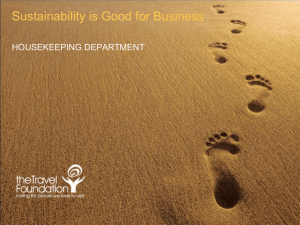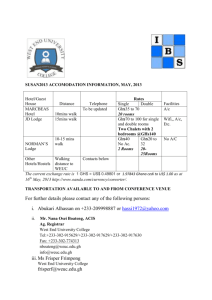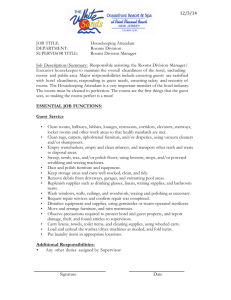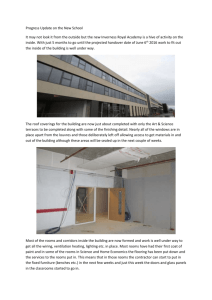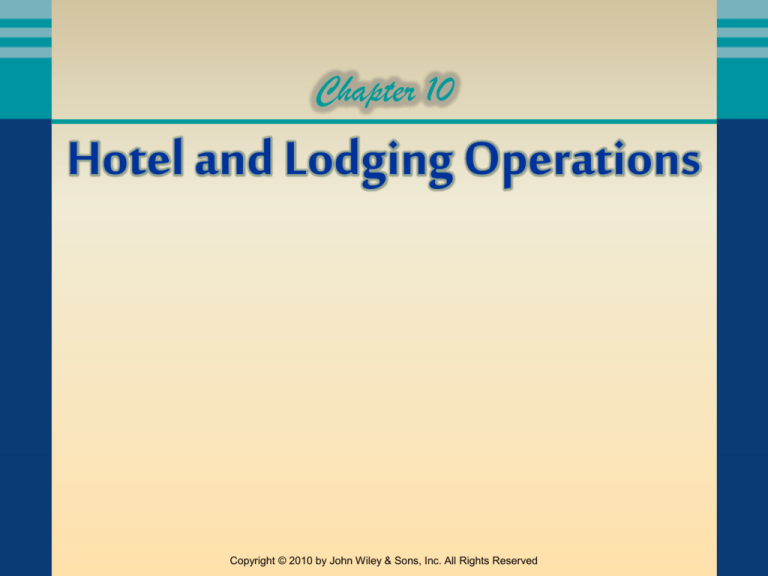
Chapter 10
Hotel and Lodging Operations
Copyright © 2010 by John Wiley & Sons, Inc. All Rights Reserved
LODGING OPERATIONS
• Whether 100 rooms or over 5,000 rooms,
functions remain essentially the same
• Size does affect how responsibilities are
separated however (and staffing)
• Hotels are generally
divided into three
major functional
areas
HOTEL OPERATIONS
• Rooms Division
– Includes Front Desk, Reservations, Uniform
Services (Security, etc.), and Housekeeping
• Food and Beverage department
– Includes Restaurants, Bars, Banquets and Room
Service
• Staff and support departments
– Includes Accounting, Engineering, Marketing,
Human Resources, and Contracted areas
ROOMS DIVISION
• The Rooms Division is the heart of the hotel
• It is the main business of the hotel and the
main source of revenue
• Rooms can contribute 70 percent or more to
overall revenue and even more to profit
ROOMS DIVISION
• The center of activity in the Rooms Division is
the Front Office
• It is overseen by the Resident Manager (or
Assistant General Manager) and various
department heads
• Responsibilities include checking guests in,
checking them out, securing payment, listening
to complaints, communicating with other
departments, determining room availability,
and selling additional rooms
RESERVATIONS DEPARTMENT
• Reservations can be made by the guest via
other methods (more and more online) but
many requests are still made through the
hotel’s reservation department
• Reservations must maintain contact with other
departments as well as other reservations
channels to be able to forecast available rooms
RESERVATIONS DEPARTMENT
• The Reservations department attempts to
maximize (1) room rate and (2) occupancy rate
• This is known as Yield Management –
maximizing these two at any given time
• Reservations departments must consider city
wide events, competition, minimum stays, etc.
HOUSEKEEPING
• The essential requirement that guests have is to
be able to check into a clean room
• The Housekeeping Department is responsible
for cleaning of guest rooms, stocking essential
supplies and amenities, laundry (sometimes)
and maintenance of public areas
• Housekeeping is one of the largest departments
in the hotel (up to 50 % of all employees)
HOUSEKEEPING
• The Executive Housekeeper is the head of the
department
• He or she must be adept at scheduling,
coordinating, managing people, etc.
• Room Attendants are responsible for cleaning
of individual guest rooms
• Housekeepers work from a Rooms Report,
which provides them with the status of all guest
rooms from which they can prioritize their work
HOUSEKEEPING
• The Housekeeping Department must know at
any given time, the occupancy of the hotel, the
number of guests checking in, the number of
guests checking out, the number of guests
staying over, late check-outs, etc.
• Rooms can take as little as 15 minutes or as
much as 1 hour to clean and prepare for the
next guest
• Check-in and check-out times are based in large
part on the time it takes to clean a room
UNIFORMED SERVICES
• The Uniformed Services Department is another
important department in the Rooms Division
• It consists of the bell staff, valet, security and
concierge
• The bell staff assists with luggage, acts as an
escort, and answers questions
• The valet assists with parking
UNIFORMED SERVICES
• The concierge is the resident expert in
activities, events, restaurants, and attractions
• The position of concierge is becoming more
important as hotels try to offer a higher level of
guest services
• There is an international association for
concierges (Les Chefs d’Or)
• Sometimes this responsibility falls to the bell
staff or the front desk clerks in smaller hotels
SECURITY
• With crime increasing in many cities
(particularly downtown areas), security is
becoming increasingly important
• Hotels are required to provide “reasonable
care” of their guests which includes general
security, locks and lighting and security of guest
belongings
SECURITY
New security measures that have been
introduced in recent years include:
In-room safes
Keyless locks (with magstrips)
Tighter security at the front desk
Redesigned hotels where guests (and
others) must pass through the lobby
FOOD AND BEVERAGE
• The Food and Beverage department can
contribute 15 to 20 percent of overall revenue
• It should be a profit center but does not always
make money for the hotel
• This department is headed up by a Food and
Beverage Manager who oversees both front-ofthe-house and back-of-the-house functions
FOOD AND BEVERAGE
• Banquets – are often profitable for hotels. Can
support meetings and conferences or outside
functions
• Some hotels are limiting what they offer and
others are outsourcing
• Bars, room service,
food production,
and stewarding are
other areas
STAFF AND SUPPORT DEPARTMENTS
Sales and Marketing
Responsible for “creating customers”
Largely revolves around selling “blocks” of rooms
Can be a large department in convention hotels
specialized by market
Accounting
Role is moving beyond just bookkeeping
Includes overseeing the “house ledger” and the “city
ledger”
Also, includes the night audit
STAFF AND SUPPORT DEPARTMENTS
Human Resources
Labor intensive industry requires progressive HR
Responsibilities include supporting line
departments in all HR related activities (hiring
and recruiting, training, staffing, etc.)
Engineering
Oversees heating, cooling, water, lighting,
telecommunications, energy management,
electric, other
FINANCIAL MANAGEMENT
•
•
•
•
•
Income and expenses
Revenue and profit
Changes in income and expenses over time
Outsourcing as a strategy to cut costs
Cost of maintaining a hotel
KEY OPERATING RATIOS
• Occupancy percentage =
Rooms sold ÷ Total rooms available
– Example: 500 room hotel sells 300 rooms
• Average rate =
Dollar sales ÷ Number of rooms sold
– Example: $18,000 in sales
KEY OPERATING RATIOS
• Number of guests per occupied room =
Number of guests ÷ Number of occupied rooms
• Revpar – revenue per available room = Rooms
revenue ÷ Available rooms or Paid occupancy
percentage * ADR (Average Daily Rate)
• Average rooms cleaned per room attendant
day = Number of rooms occupied ÷ Number of
eight-hour shifts
CAREER ENTRY POINTS
• Front office
• Accounting
• Sales and
marketing
• Food and
beverage

